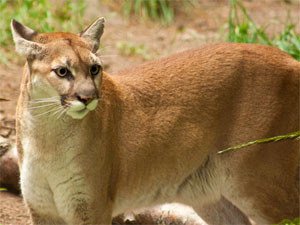Cougar population regenerates after 100 years of decline, U of M researcher finds

MINNEAPOLIS / ST. PAUL (06/14/2012) —American mountain lions, or cougars, are re-emerging in areas of the United States, reversing 100 years of decline, new research by a University of Minnesota scientist shows. The evidence, published today in The Journal of Wildlife Management, raises new conservation questions such as how humans can live alongside the returning predators.
“The cougar population declined dramatically from 1900, due to both hunting, and a lack of prey, leaving the remaining population isolated to the American west,” said Michelle LaRue, a conservation biology Ph.D. student at the University of Minnesota and researcher in the U of M College of Science and Engineering's Polar Geospatial Center. “Here we present the hard evidence that the western population has spread, with cougar populations re-establishing across the Midwest.”
Three main cougar populations exist in the Midwest, centered around the Black Hills in South Dakota, but cougars are venturing far outside of this range. One male cougar from the Black Hills was found to have traveled 2,900 kilometers through Minnesota, Wisconsin and New York, before ending up in Connecticut.
“While the distance the Connecticut cougar traveled was rare, we found that cougars are roaming long distances and are moving back into portions of their historical range across the Midwest,” LaRue said. “Our study took in over 3.2 million kilometers of territory, confirming the presence of cougars from Texas, Arkansas and Nebraska, to the Canadian provinces of Ontario and Manitoba."
Working alongside scientists from Southern Illinois University and The Cougar Network, LaRue and Principal Investigator Clay Nielsen analyzed cougar sightings since the 1990s to characterize confirmed sightings over time, assess habitat suitability and confirm where cougar populations are being re-established.
Aside from confirmed sightings, the team’s evidence included carcasses, tracks, photos, video, DNA evidence, and cases of attacks on livestock across 14 states and provinces of North America. Only sightings which were verified by wildlife professionals were included, while sightings of animals known to be released from captivity were excluded to ensure only natural repopulation was analyzed.
The results reveal 178 cougar confirmations in the Midwest with the number of confirmations steadily increasing between 1990 and 2008. About 62 percent of confirmed sightings took place within about 10 miles of habitat that would be considered suitable for cougar populations.
When cougar carcasses were recovered, 76 percent were found to be male. As the Connecticut example shows, males are capable of traveling long distances; this finding suggests males are leading a stepping-stone dispersal of the cougar population.
“This evidence helps to confirm that cougars are re-colonizing their historical range and reveals that sightings have increased over the past two decades,” LaRue said. “The question now is how the public will respond after living without large carnivores for a century. We believe public awareness campaigns and conservation strategies are required across these states, such as the mountain lion response plans already in place in Nebraska and Missouri.”
This paper is published in the The Journal of Wildlife Management. To request a copy contact Lifesciencenews@wiley.com or +44 (0) 1243 770 375.
Full Citation:
LaRue. M, Nielsen. C, Dowling. M, Miller. K, Wilson. B, Shaw. H, Anderson. C, ‘Cougars Are Recolonizing the Midwest: Analysis of Cougar Confirmations during 1990–2008,’ Journal of Wildlife Management, Wiley-Blackwell, June 2012, DOI: 10.1002/jwmg.396
Paper URL upon Publication:
http://doi.wiley.com/10.1002/jwmg.396
Contact the Author:
Michelle LaRue can be contacted via:
Becky Beyers, University of Minnesota
Phone: (612) 626-5754
Email: bbeyers@umn.edu
Dr. Clay Nielsen can be contacted via:
Tim Crosby, Southern Illinois University Carbondale
Phone: 618.453.5308
Email: crosby@siu.edu
About the Authors:
Michelle LaRue is a Research Fellow for the Polar Geospatial Center at the University of Minnesota, and is currently pursuing her Ph.D. in Conservation Biology. Michelle received her B.S. in Ecology from Minnesota State University-Mankato, where she gained research experience on bat ecology, and white-tailed deer populations while an intern with the Minnesota Department of Natural Resources. At Southern Illinois University Carbondale, Michelle received her M.S. in Wildlife Ecology studying potential cougar habitat and dispersal corridors in the Midwest with Dr. Clay Nielsen. Michelle is interested in habitat selection, large carnivores, and the use of GIS and remote sensing techniques to answer broad spatial and ecological questions.
Clayton K. Nielsen, Ph.D., is Assistant Professor of Forest Wildlife in the Cooperative Wildlife Research Laboratory, Department of Forestry, and Center for Ecology at Southern Illinois University Carbondale. He is a Certified Wildlife Biologist® and Director of Scientific Research for The Cougar Network. In addition to having published >120 scholarly works and having given >300 guest lectures and presentations at professional meetings, his research has been showcased by major media outlets such as TIME, National Geographic, NPR, History Channel, and Discovery Channel. Dr. Nielsen and his graduate students study ecology and management of wildlife species, with a focus on mammals.
